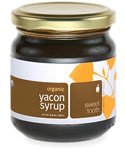The Sticky Truth Re: Sugar Alternatives
Americans love sweets. We start the day with a sweetened breakfast cereal, breakfast bars, toast with a sweet spread, or a breakfast pastry. As the day progresses, we indulge in sweet beverages from soda to tea, and keep our sweet tooth satiated with candy, gum, ice cream and the like.
The sweetness we crave can come from refined sugar, chemically derived artificial sweeteners (like aspartame or Splenda), or a host of “natural” products that are less processed, so they contain nutrients that are otherwise removed in the refining process. Natural sweeteners cause less environmental damage than sugarcane plantations, and many offer more complex flavors than plain old sugar.

Organic honey that hasn’t been pasteurized, clarified or filtered is the most eco-friendly sweetener: It’s raw, unprocessed, minimally packaged and, if you’re lucky, local. Maple and sorghum syrups are also minimally processed; the sap or juice is boiled to remove the water, concentrating the sugars and minerals.
Palm sugar is a traditional sweetener in Southeast Asia and India. The collected flower nectars are kettle-boiled into thick syrup, then dried and ground to produce a grainy, crumbly sugar that’s organic, un-bleached, contains amino acids, B vitamins and minerals, and has a low glycemic index. Palms grow in diverse agro-ecosystems which support wildlife habitats, restore damaged soils and require little water. Per acre, coconut palms produce 50-75% more sugar than sugar cane plantations, and use less than 1/5th of the nutrients for that production.

The Yacñn is related to the sunflower and native to the Andes. Its crisp, sweet tuberous roots have long been eaten by the Incas of Peru and Bolivia. The syrup is made by juicing the tubers, then concentrating the liquid by boiling. Because the Yacñn’s sweetness comes chiefly from fructo-oligosaccharides, compounds the human body doesn’t absorb, the syrup is a low-calorie, low-glycemic sweetener. Ac-cording to a study in Clinical Nutrition, “Daily intake of yacñn syrup produced a significant decrease in body weight, waist circumference and body mass index.”
Luo Han Guo has been cultivated for centuries in southwest China. In 1995, Procter & Gamble patented a process to isolate the fruit’s sweet mogrosides compounds, creating a powder that is 250-300 times sweeter than sugar. Today, several companies sell commercially prepared luo han guo products, some combined with herbs or sugar alcohols. These include powdered luo han guo, Lo Han Sweet, SweetFiber and PureLo.

Stevia is an extremely sweet herb native to Paraguay, where it has been used for over 1,500 years. In Japan, it’s more common than sugar. The herb is 200-300 times sweeter than sugar, but has no calories or carbohydrates and a low glycemic index. The leaves also contain fiber, vitamins A and C and minerals. But there are many concerns about its safety.
Studies suggest stevia may interfere with metabolism and absorption of carbohydrates, lead to male reproductive problems and cause genetic mutations. The herb is not approved for use in the European Union or Canada and was banned as a sweetener in the U.S. until December 2008, when the Food and
Drug Administration approved certain sweet compounds extracted from its leaves. Since then, Truvia (Coca-Cola and Cargill) and PureVia (PepsiCo and Merisant Worldwide) have come on the market as zero-calorie stevia sweeteners.

Agave syrup, a sweetener developed in the last decade, comes from the sap of the Agave Tequilana plant. The syrup (also called “nectar”) is marketed as a healthy alternative to sugar: raw, 100% natural, with a low glycemic index. But according to Dr. Ingrid Kohlstadt, a fellow of the American College of Nutrition and an associate faculty member at Johns Hopkins School of Public Health, it’s just high-fructose syrup “with great marketing.” That’s because converting the plant’s juicy sap into syrupy nectar is a complicated process involving heat and enzymes. To keep the syrup from fermenting, the natural enzymes are removed. When chemically processed, the sap becomes hydrolyzed high-fructose inulin syrup devoid of nutrients.

